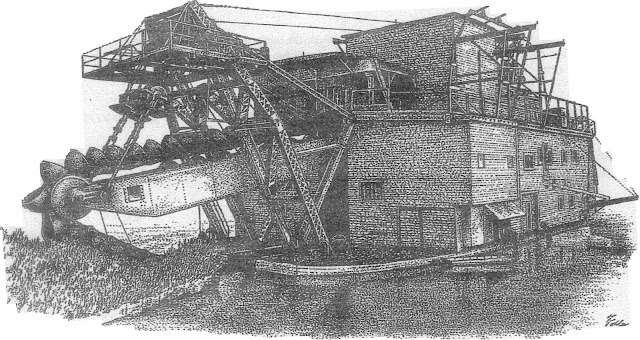Sumpter Valley Dredge - From Oregon State Parks and Recreation Pamphlet
In school we learned about the California Gold Rush of 1849. That started a big migration west. There were more strikes over the years and each time it caused a new migration toward the alleged find. Some people never learn.
Holmes Stereo Card - Uses Stereopticon Viewer
The best way to make money during a gold rush was to sell stuff to the rushers. Washington State had a building boom around 1910 – 1911. Many of the rail lines, banks, and municipal buildings were built in that era. Why? Because somebody who couldn’t keep his mouth shut discovered gold in Alaska.
The Alaskans didn’t want thousands of bodies frozen in the snow so they made rules that anyone going to look for gold had to come with supplies. Tons of supplies. People in Washington, Oregon, and California sold tons of supplies to these gold seekers and financed a building boom.
In Oregon gold was being panned in mountain streams. The gold seeker washed creek gravel in a pan and got a little smidgen of gold dust. Lots of backbreaking work for a little bag of glitter. Some thought there had to be a better way. “Why not use some of them new fangled machines they got?” For example the telephone. Or the automobile? Something.
Drag Line Bucket
Some of the ideas were a little closer to addressing the problem. One idea focused on the steam shovel. They brought in drag line type shovels. A few of those buckets are still there. Very heavy to haul off.
But that still left the problem of finding a dude big enough to swirl the giant pan. “Hmm,” said several old timey gold seekers, “What we need is a machine that can scoop up the creek bottom and do all the panning too”
See, the issue is stream beds are full of large roundish rocks that are very hard to pan by hand. At least for those wimps. I can toss those things around like tiddly winks. But several people studied the problem. “There must be a way” they said to their donkeys as they sat by the stream panning.
Dredge Bucket Line
In New Zealand somebody invented a thing called a paddock dredge. Look at the photos. The short story is this: It’s a boat hull with a gold extraction factory sitting on top. It’s also called a Yuba Style dredge. The front end drags up buckets full of rocks, gravel, and gold. They sluice the gold and dump the rocks and gravel out the back. It makes its own moving pond and floats forward as it works.
Dredge Hull Near Bourne in Its Pond
The dredge in Sumpter is actually the third one. They two earlier ones. One built in 1913 and another in 1915. These two quit in the mid 1920s. Some of the hardware was removed and used to make a new one. On one end there’s a bucket ladder. It can reach down 13 feet. The buckets on the Sumpter Dredge could scoop up 9 cubic feet each at 25 buckets per minute. A lot faster than a pan. Plus a lot deeper.
The Sumpter Dredge could process 100 acres a year. Your assignment: Go to Google Earth and find Sumpter, Oregon. Zoom in close enough to see the little photo icons. Click on these and see photos. Then follow highway 410 southeast to highway 7. Continue to follow highway 7. See the odd looking grey land? Zoom in close and you’ll see the side to side deposits. These are the tailings from the dredges that worked the valley.
The paddock dredge on display in Sumpter is the last of three (or four) that worked the valley. It’s an amazing contraption that has to be visited to appreciate. The people of Sumpter and Baker City, as well as several others, got the dredge fit for visitors. Sumpter itself is made up to look like it did 100 years ago. They also have a railroad station in town. A narrow gage train carries tourists to McEwen and back during the warm months. I’m impressed that they made their town into a tourist destination to keep it alive. You can eat, camp, and wander around the state park. Train rides are also fun. Visit the dredge, it’s worth the trip.
Dredge Buckets in Water Showing How They Scooped Up Rocks
The Sumpter Valley Dredge was left in its pond when the dredging stopped in 1954. Another hull is up the road toward Bourne. A third is near the McEwen station. Those two are just rotting hulls and all the machinery has been removed.
In addition to the dredge and the railroad there are several old mining and logging artifacts on display. The map shows ghost towns in the area. Bourne is a ghost town. If you like having roads all to yourself eastern Oregon is the place to go.
Al







No comments:
Post a Comment